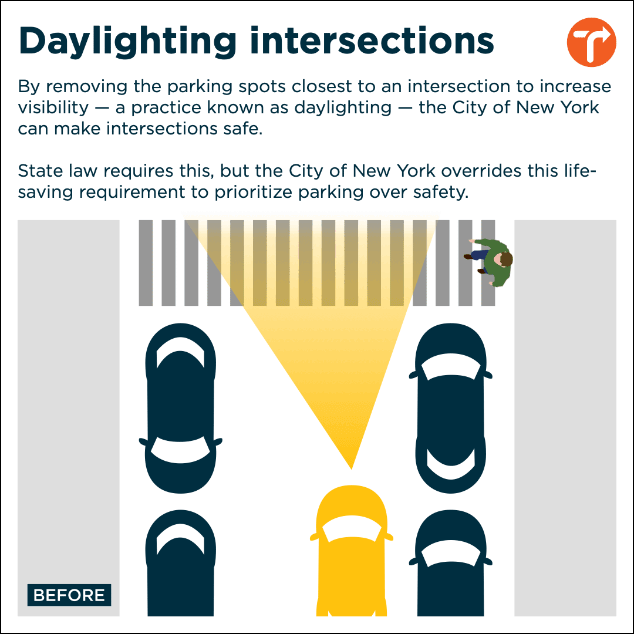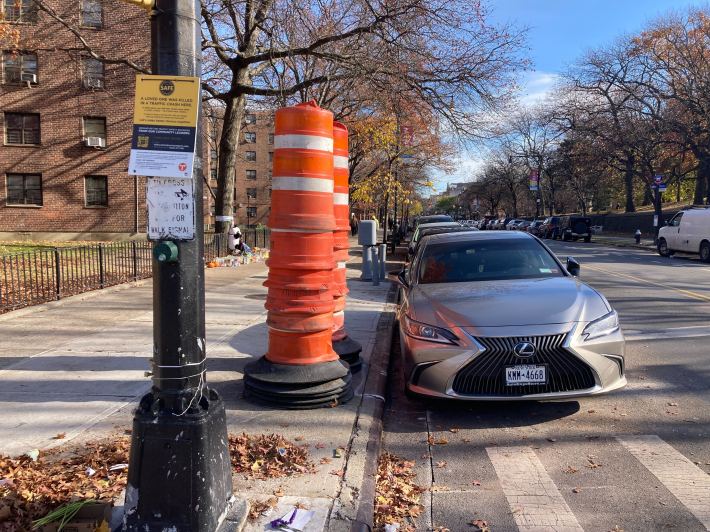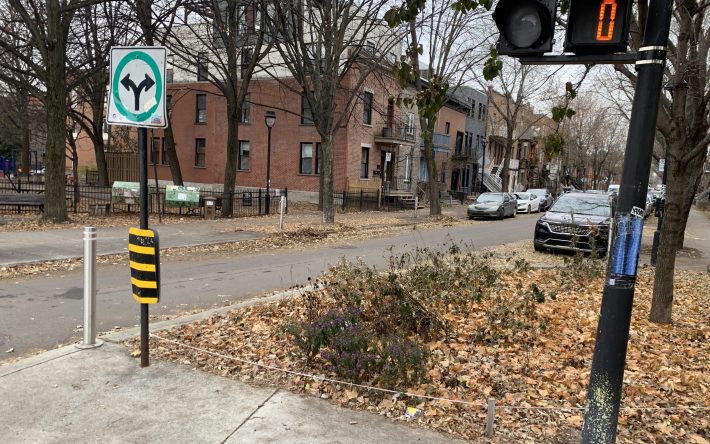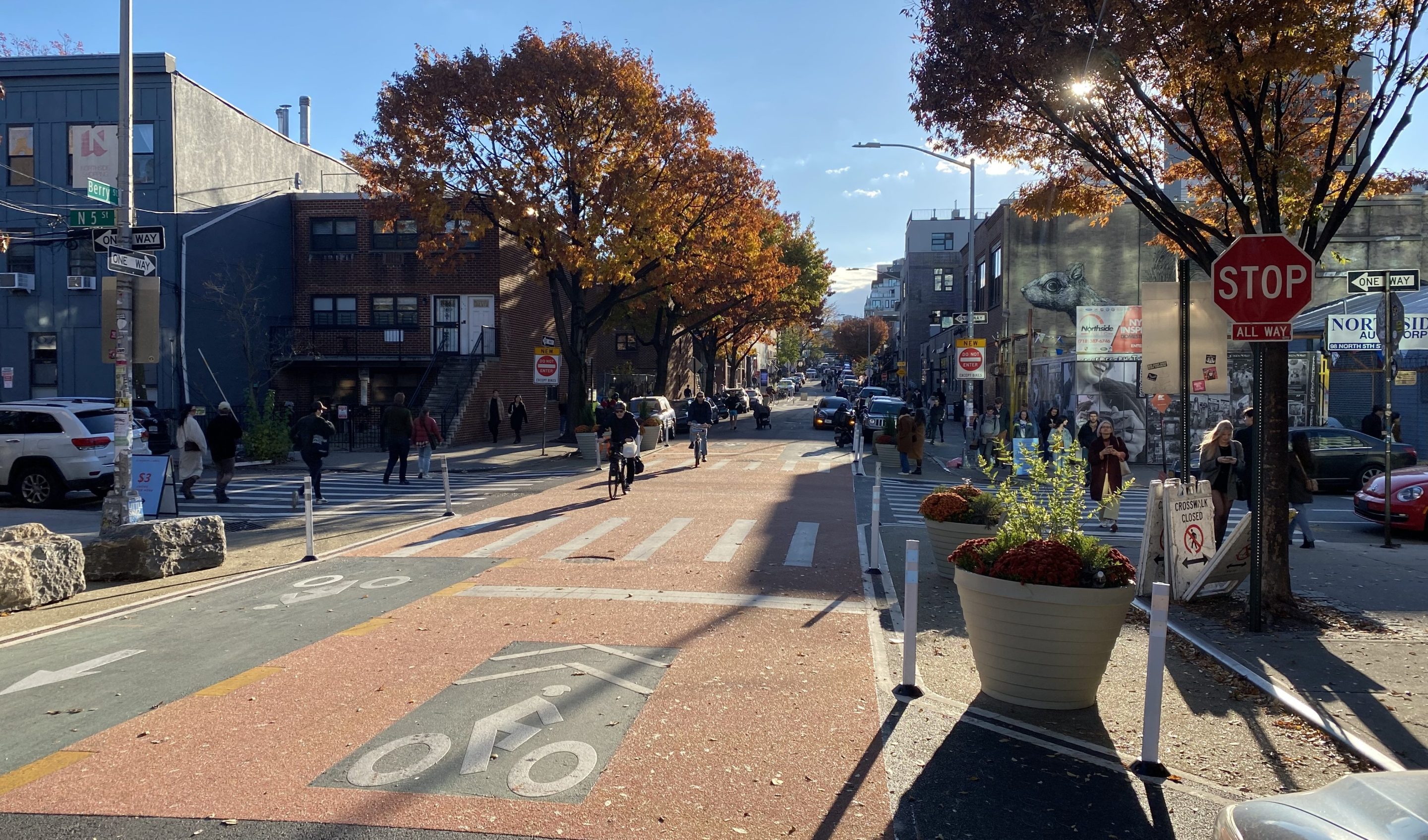Hizzoner is starting to see the (day)light.
The city will remove car parking near 1,000 intersections a year, following the well-established street safety design for better visibility known as daylighting, Mayor Adams announced Thursday, but road officials has yet to add the life-saving measure at a Brooklyn corner where a 7-year-old boy was killed by an NYPD tow truck driver more than a month later.
The mayor’s promise is a 10-fold increase over the 100 intersections the city will have to daylight annually starting in 2025 per a recent Council law, but with nearly 47,000 intersections across the five boroughs, it would still take decades to fix all street corners at that rate.
DOT will install additional safety upgrades — such as raised crosswalks, extended sidewalks, and leading traffic signals for pedestrians — at 1,000 more intersections next year, according to City Hall.
“Protecting New Yorkers is my most sacred responsibility as mayor, and that holds true for traffic violence just as much as any other form of violence. Our streets must be safe places for all New Yorkers — pedestrians, cyclists, and motorists alike,” Mayor Adams said in a statement.
Hizzoner’s new intersection safety efforts come on the heels of a growing chorus of several community boards calling on officials to put safety over parking and implement universal daylighting citywide. The issue has been a key campaign by Open Plans, a livable streets non-profit.

State law already bars parking within 20 feet of crosswalks, but the city has long exempted itself from that provision to provide more space for the storage of privately owned vehicles. The city's own stats show that intersections account for 55 percent of pedestrian traffic deaths and 79 percent of injuries.
Daylighting has proven to decrease traffic violence in cities like Hoboken, New Jersey, which has aggressively worked to keep the spaces near crosswalks clear and hasn’t had a road death since 2017, according to officials from the Garden State city.
Following the death of a 7-year-old Dolma Naadhun at an intersection with poor visibility in Queens last February, Queens Community Board 1 passed a resolution calling for the city to opt back into state daylighting requirements, which inspired similar votes from more civic boards in Brooklyn and Manhattan in recent months.
“In districts across the city, community boards have been adopting daylighting resolutions; largely because daylighting is simple, compelling, and proven - not to mention that it’s actually the law,” said Sara Lind, co-executive director at the advocacy group Open Plans (which shares a parent organization with Streetsblog), which has organized for community boards to push for daylighting over the past year. “The push to daylight all New York City’s intersections is gaining steam, but we’ll need the City to actually commit to doing the work.”
Another horrific crash at an undaylighted Brooklyn intersection happened last month, when an NYPD tow truck driver turned and killed 7-year-old Kamari Hughes, prompting more calls from locals to fix the dangerous crossings.
City officials promised to fix that corner, and retimed the traffic signals to give pedestrians more time, but DOT has yet to finish its plans to raise the crosswalk and add daylighting there:

Last week, a group of seven north Brooklyn elected officials from all levels of government followed up with a letter [PDF] to DOT Commissioner Ydanis Rodriguez advocating for universal daylighting, calling it a “simple and effective method for improving safety at dangerous intersections and quality of life.”
Some 30 advocacy and community groups in that part of the borough also signed an open letter [PDF] calling on the city to daylight intersections, emphasizing that they need to do so with physical infrastructure so that cars don’t just park in the spaces illegally, as seen below on Fourth Avenue.
This intersection on BK’s 4th Ave is “daylighted” on paper but since it routinely hosts parked SUVs & work by the adjacent body shop, drivers, cyclists & pedestrians proceeding legally cannot see each other. Whether this is more paint or physical installations matters a lot https://t.co/6Fp4aW3cQA pic.twitter.com/1PMYQMMA0q
— Jon Orcutt (@jonorcutt) November 30, 2023
It’s unclear how many of the 1,000 annual intersections will get hard barriers to keep drivers out, but Rodriguez earlier this year echoed the need for physical protection, telling the Council that daylighting "must be implemented with physical infrastructure in the newly opened space to prevent vehicles from turning more quickly.” The Commissioner at the time also defended the city’s decision to opt out of the state law saying daylighting is “not the right solution everywhere.” The DOT has said, for instance, that at some intersections, daylighting may simply allow drivers to make their turns faster, but that is a problem that can be solved with cement, as is done in many other cities.

Adams has established a track record of failing to meet legally mandated street safety requirements under the City Council's Streets Master Plan law, which includes annual minimums for new miles of bus and bike lanes. The mayor told DOT workers last month he cared more about listening to "input," rather than how many miles of safer transportation paths he completes.
As part of Adams's street safety announcement, the Department of Citywide Administrative Services unveiled an expansion of its test of speed restriction technology from 50 city vehicles to 300, including 50 school buses, just over 1 percent of the city’s total 28,520 vehicles, according to the latest Mayor’s Management Report.
The so-called active intelligent speed assistance system kicks in when drivers try to go above a set speed and slows their vehicle back down, however motorists can still disable the control mechanism at the push of the button.
DCAS Commissioner Dawn Pinnock didn’t specify which agencies will get the tech, but said the agency is “in talks” with NYPD to install the gadget on non-emergency vehicles like the tow truck whose driver killed Kamari, according to police.
“We do have vehicles that are legally allowed to speed in order to provide services to New Yorkers and to respond to emergencies, but we are currently in talks now to look at potentially installation on tow trucks, as well as non-emergency vehicles for NYPD,” Pinnock told reporters.
The Police Department will start adding statistics on traffic fatalities to its CompStat online dashboard starting in January, according to the NYPD Transportation Chief Philip Rivera, who revealed that his family has also been affected by road violence.
“I lost my cousin at the age of 7, and I understand that this is not unique to a lot of people, so this is personal to me as well,” Rivera said at a press conference on Thursday.
DOT will also break down more modes of transportation in its traffic fatality data, detailing if victims were pedestrians, riding a traditional bike, motorcycle, e-bike, moped, stand-up e-scooter, dirt bike or ATV, other motorized two-wheeled device, car, SUV, or other motor vehicle.
The Council's Transportation Committee Chair lauded the mayor's push for more daylighting.
"Daylighting intersections is a proven safety measure that increases visibility to oncoming traffic and reduces danger for pedestrians and drivers alike," Council Member Selvena Brooks-Powers said in a statement. "This has been a priority issue for me ... and I'm glad to see the administration moving this work forward."






